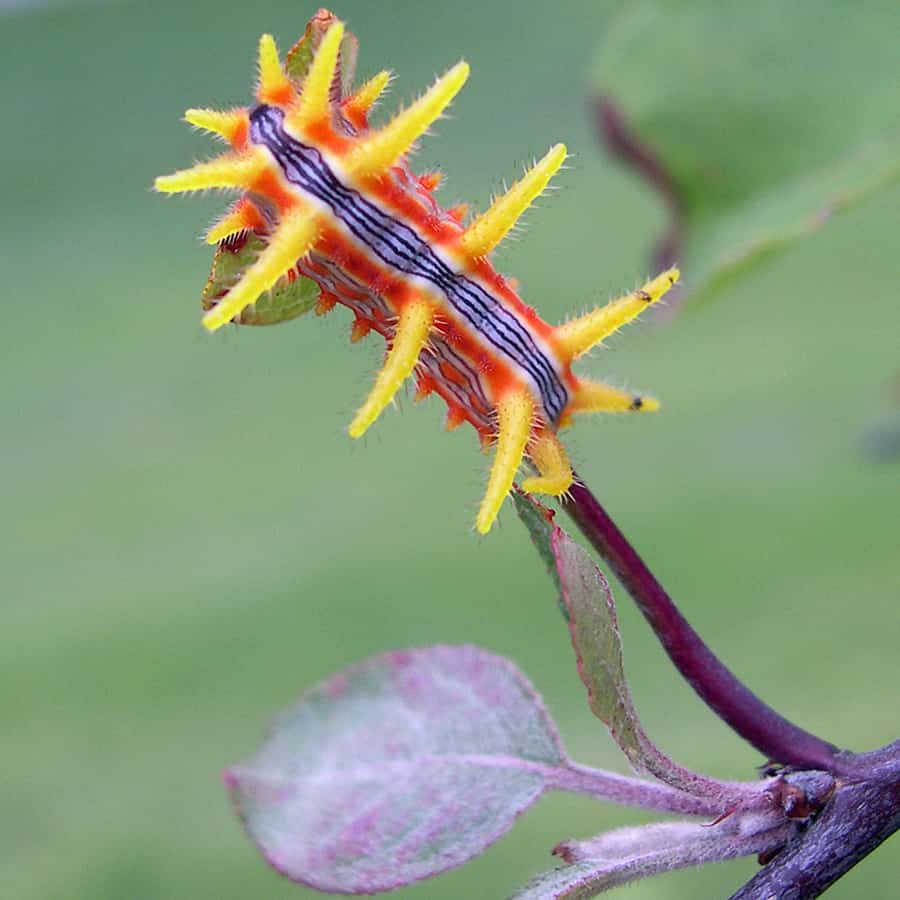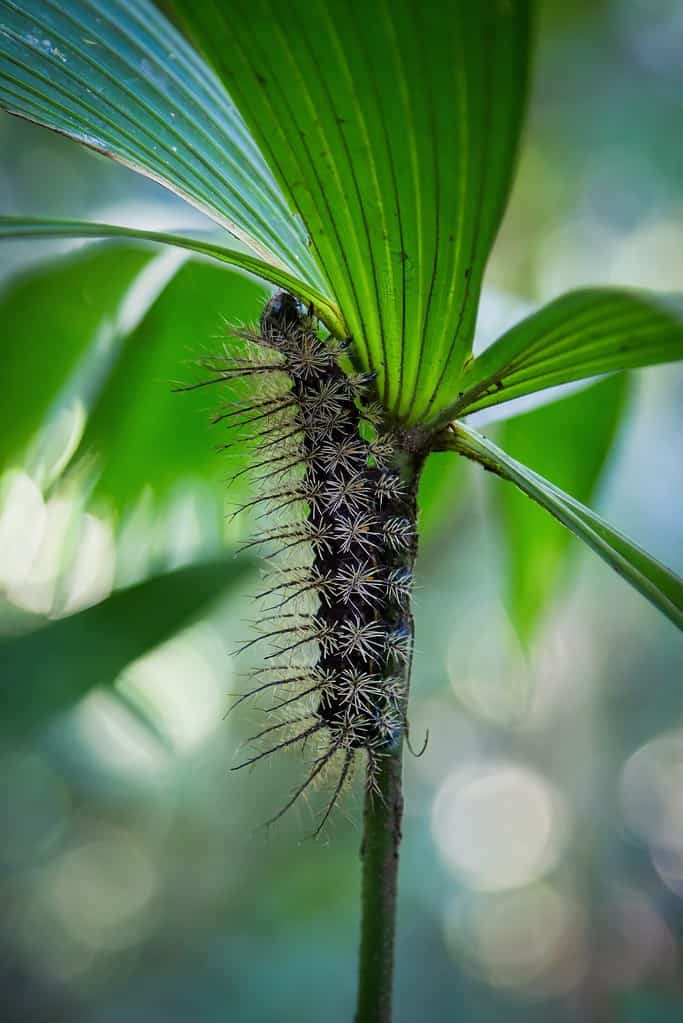Generally speaking, it is unlikely for a caterpillar to bite a human in a way that causes significant pain. Caterpillars do not sting or bite in the traditional sense. While some caterpillars possess spines or hairs that inflict mild pain, they are not designed to harm humans. The discomfort comes from contact with their toxic or venomous spines or hairs called setae (singular, seta). The setae in some caterpillars contain toxins or venom that can cause skin irritation or allergic reactions when they come into contact with the skin. With one notable exception, caterpillars do not pose a mortal threat to humans. Keep reading to learn more about these fascinating insects, including prevention and treatment tips for instances when someone gets a little too close for comfort.

The setae in some caterpillars contain venom. These can cause skin irritation or allergic reactions.
©Stephanie Gelman/Shutterstock.com
Do Caterpillars Bite or Sting?
The painful reactions caused by caterpillars are not the result of a bite, but rather from contact with their toxic or venomous spines or hairs called setae. These spines or hairs can cause irritation and burning sensations when they come into contact with the skin. The setae are embedded in the caterpillar’s body. When touched or brushed against, they can break off and release toxins or irritating substances. These substances can cause a range of reactions. Mild irritation to more severe symptoms can result dependent on individual sensitivity and the specific species of caterpillar involved.

Painful reactions caused by caterpillars are not from a bite, but rather from contact with their toxic spines.
©iStock.com/irin717
Examples of Dangerous Caterpillars
There are approximately 17,500 species of butterflies in the world and 750 species in the United States. Out of the 160,000 separate moth species worldwide, 11,000 call the U.S. home. Of the 11,750 species of moths and butterflies in the U.S., fewer than 20 have the ability to inflict pain.
Some tussock moth caterpillars (Erebidae) possess hairs that can cause skin irritation or allergic reactions. The hairs contain irritants or toxins that they release upon contact. Said contact results in symptoms like itching, rashes, or localized skin inflammation. Slug caterpillars (Limacodidae) resemble slugs more than caterpillars. Some species within this family, such as the stinging rose caterpillar (Parasa indetermina), possess spines or bristles that can cause a stinging or burning sensation if touched. The reaction is typically localized to the area of contact. Puss moth caterpillars (Meghalopygidae), particularly the southern flannel moth (Megalopyge opercularis), have venomous spines. Contact with these spines can cause intense pain and swelling.

The stinging rose caterpillar possesses spines that can cause a stinging or burning sensation if touched.
Butterflies vs. Moths
While the majority of caterpillars with irritating setae belong to moth species, there are some butterfly caterpillars that possess stinging hairs as well. While it is less common among butterflies,
some species in the Nymphalidae family, like mourning cloak butterfly (Nymphalis antiopa) caterpillars have stinging spines.

The majority of caterpillars with irritating setae belong to moth species.
©Massimiliano Paolino/Shutterstock.com
Toxin vs. Venom
Caterpillars with toxic setae possess specialized hairs or spines that contain toxins. These substances are primarily for defense against predators. When something disturbs these caterpillars’ setae, the hairs release toxins. These toxins cause skin irritation, allergic reactions, or other symptoms. Venomous caterpillars have setae connected to venom glands or sacs. These caterpillars can actively inject venom into their target through their setae. When the setae puncture the skin, the venom leads to localized reactions or systemic effects. The severity of the reaction can vary depending on the species and individual sensitivity. Both toxic setae and venomous setae serve a defensive purpose. The main difference lies in the active injection of venom by caterpillars with venomous setae, while toxic setae primarily release toxins when disturbed.
Range of Reactions
Skin irritation is the most common reaction to caterpillar setae. In extremely rare cases, however, contact with caterpillar setae can lead to more severe allergic reactions, including anaphylaxis. Anaphylaxis is a severe, potentially life-threatening allergic reaction that can affect multiple body systems.
While anaphylaxis from caterpillar setae is rare, it is possible for certain individuals to have a hypersensitivity or allergy to the substances present in the setae. Anaphylactic reactions typically involve symptoms such as difficulty breathing, swelling of the face, lips, or throat, rapid heartbeat, dizziness, and a drop in blood pressure. If someone experiences these symptoms after contact with caterpillar setae, it is important to seek immediate medical attention.
The majority of caterpillar encounters do not result in anaphylaxis or severe allergic reactions. However, individuals who have known allergies or sensitivities to certain substances should be particularly cautious and avoid direct contact with caterpillars that have spines, hairs, or bristles.
Lonomia obliqua: Exception to the Rule
Though you are highly unlikely to encounter a deadly caterpillar in North America, folks in South America aren’t so fortunate! The larvae of the giant silkworm moth (Lonomia obliqua), commonly known as the assassin caterpillar, is a species of caterpillar native to Argentina, Brazil, Paraguay, and Uraguay. While the caterpillar itself does not possess the ability to kill humans directly, its venom can be extremely dangerous and potentially lethal.
Lonomia obliqua caterpillars have numerous spines along their bodies, which are covered in venomous bristles. When a human comes into contact with these caterpillars or their spines, venom can be injected into the bloodstream through the skin. The venom contains a mixture of toxins that can cause severe health complications. The primary concern with Lonomia obliqua is its potential to cause a condition known as Lonomia envenomation syndrome. The symptoms of this syndrome include intense pain, swelling, and inflammation at the site of contact. As the venom spreads throughout the body, it can lead to internal bleeding, kidney failure, and other systemic complications. In severe cases, Lonomia envenomation syndrome can be life-threatening. The venom of the Lonomia obliqua caterpillar has been attributed to several human fatalities, primarily in Western Brazil.
Immediate medical attention is crucial if someone comes into contact with Lonomia obliqua caterpillars. Treatment typically involves the administration of antivenom and supportive care to manage the symptoms and prevent complications. While fatalities resulting from Lonomia obliqua envenomation are relatively rare, they have been reported, particularly in cases where medical treatment was delayed or inadequate.

The larvae of the giant silkworm moth (
Lonomia obliqua) are commonly known as the assassin caterpillar.
©Fusco Davide/Shutterstock.com
Prevention
Being apprised of best practices for avoiding caterpillars or their habitats will help prevent caterpillar stings. Educate yourself about the local caterpillar species in your area and their potential dangers. Be aware of any caterpillars that are toxic or venomous. Do not handle caterpillars or touch them with bare hands, especially if you are uncertain about their identification or potential hazards. Remember that even seemingly harmless caterpillars can have irritating setae. If you are working or spending time in areas where caterpillars are present, consider wearing garments that minimize skin exposure. Tucking pants into socks or boots will prevent caterpillars from crawling up your legs!
Take care when walking through forests, grassy areas, or gardens where caterpillars may be present. Look for signs of caterpillars or their nests. Teach children about caterpillars. Educate them about the potential risks associated with handling caterpillars and teach them to avoid touching or picking up caterpillars they may come across. If you spot a caterpillar, admire it from a safe distance without getting too close. Regularly inspect plants and trees in your yard for signs of infestation and take appropriate measures to manage caterpillar populations when necessary. Prevention is key when it comes to avoiding caterpillar stings. By being aware of the potential risks and taking appropriate precautions, you can reduce the chances of encountering harmful caterpillars.
Treatment Tips
If you experience a skin reaction after coming in contact with a caterpillar, it is important to treat the affected area promptly. Immediately rinse the affected area with mild soap and water to remove any venom, spines, or irritating substances from the caterpillar. Gently pat the area dry with a clean towel.
If visible spines or hairs are still present on the skin, you can use adhesive tape to gently lift and remove them. Avoid using your fingers or tweezers, as this can cause further irritation or break the spines, increasing the risk of venom release.
Use a cold compress or ice pack wrapped in a cloth to apply gentle pressure on the affected area. This can help reduce swelling and alleviate pain. Over-the-counter remedies such as antihistamine creams, calamine lotion, or hydrocortisone cream can be applied to the affected area to relieve itching, inflammation, and discomfort. Oral antihistamines, like loratadine, may be taken for more acute reactions. If the skin reaction is severe, persists, or worsens, or in the presence of other troubling symptoms, it is important to seek medical attention. A healthcare professional can provide a proper assessment, prescribe stronger medications if necessary, and ensure appropriate treatment for any potential complications.
The photo featured at the top of this post is © Jay Ondreicka/Shutterstock.com
Thank you for reading! Have some feedback for us? Contact the AZ Animals editorial team.







